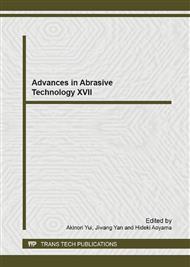p.377
p.383
p.389
p.393
p.399
p.406
p.411
p.417
p.423
Simulations of Milling Process of Inconel 718 Alloy Based on Three Dimensional Finite Element Models
Abstract:
Nickel-based alloy is known as one of the most difficult–to-machine materials and the milling process is one of the most common metal removal operations. Modeling and simulation of milling process have the potential for understanding the milling mechanism, improving cutting tool designs and selecting optimum conditions, especially in advanced applications such as high-speed milling. This paper presents a 3D coupled thermo-mechanical finite element model based on ABAQUS\Explicit for the simulation of Inconel 718 chip formation in metal cutting. In the simulations, a Lagrangian formulation with an explicit solution scheme and a penalty contact algorithm has been used. The material behavior is modeled with classical Johnson-cook plasticity constitutive model and dynamic failure criteria for element removal, coupled with adaptive meshing and mass scaling technology for limiting the calculation time. The milling tool is modeled in UG software according to the real tool geometry, and meshed as a rigid tool. In order to verify the accuracy of 3D simulation, results (cutting forces and cutting temperature) were compared with the experimental results under the same cutting conditions as the simulations. The results obtained indicate that the simulation methodology is capable of predicting the cutting forces and cutting temperature. It suggests that 3D finite element simulation model of cutting processes can be truly trusted.
Info:
Periodical:
Pages:
399-405
Citation:
Online since:
September 2014
Authors:
Price:
Сopyright:
© 2014 Trans Tech Publications Ltd. All Rights Reserved
Share:
Citation:


